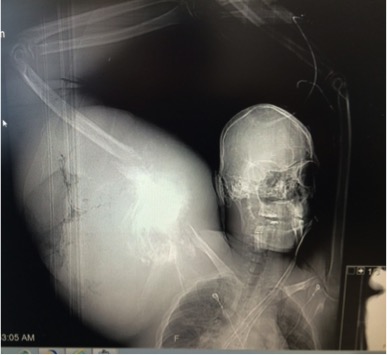Back to 2016 Annual Symposium ePosters
Vascular Control for a Forequarter Amputation of a Massive Fungating Humeral Osteosarcoma
Aleksandra Policha, MD, Melissa Baldwin, MD, Mikel Sadek, MD.
New York University Langone Medical Center, New York, NY, USA.
OBJECTIVE: Forequarter amputation (FQA) is a radical operation performed for curative or palliative treatment of malignancies of the shoulder girdle where limb salvage is not feasible. This procedure entails removal of the entire upper extremity and shoulder girdle, including the scapula and clavicle. The traditional approach to this operation involves bone and soft-tissue resection, followed by ligation of the axillary vessels. We describe a technique to minimize blood loss whereby control of the subclavian vessels is performed prior to amputation of a large tumor with significant venous congestion.
METHODS: A 34-year-old man presented in septic shock from a massive, fungating osteosarcoma of the proximal humerus (Figure). Neoadjuvant therapy was contraindicated due to the infected nature of the lesion. A multidisciplinary operative intervention was planned with Vascular Surgery, Orthopedics, and Plastic Surgery. With the patient positioned supine, a paraclavicular incision was made, through which a claviculectomy was performed, and the subclavian vessels were exposed and encircled with silastic loops. In order to minimize further potential blood loss, the subclavian artery was clamped and a guillotine amputation was performed at shoulder level in order to minimize venous hypertension and bleeding from raw surfaces during resection. The subclavian vein was then occluded with a vessel loop and the wound was rapidly packed. Following removal of the bulk of the specimen, soft tissue bleeding was mostly controlled. Ultimately, the axillary vessels were ligated at the amputation site and the subclavian vessels were unclamped. The remainder of the operation proceeded in standard fashion with improved hemostasis.
RESULTS: The patient was discharged to a rehabilitation facility on post-operative day five. At six-month follow-up, he was doing well and tolerating adjuvant chemoradiation therapy.
CONCLUSION: Advancements in adjuvant therapy have made limb-sparing surgery the standard of care for most patients with advanced-stage proximal upper extremity sarcomas. Nonetheless, FQA is still indicated in select cases, and vascular surgeons should be familiar with this procedure. In cases of large tumors with venous congestion and associated sepsis, we advocate for early subclavian vessel control, guillotine amputation of the congested extremity, followed by formal vessel ligation and forequarter resection. 
Back to 2016 Annual Symposium ePosters
|







